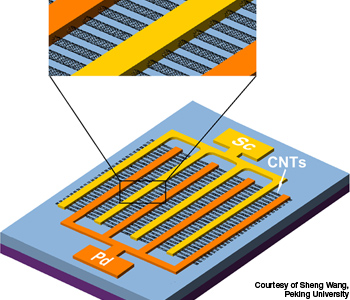
This schematic shows the design of single-walled carbon nanotube photodetector, which provides a more efficient method of collecting infrared radiation without relying on cryogenics for cooling.
Carbon nanotubes, with their strong infrared absorption and tunable band gaps, are at the heart of a new type of infrared detector that operates at room temperature (Opt. Mater. Express 2, 840).
The group of Chinese scientists led by Sheng Wang, associate professor of electronics at Peking University in Beijing, fabricated the device by laying single-walled carbon nanotubes on a silicon substrate.
The ends of the parallel nanotubes, about 60 µm in length and only 1-2 nm wide, were connected to linear electrodes, one made of scandium and the other of palladium, to make a photodiode array. Palladium and scandium are metals with different work functions, and together with the valence and conduction bands of the semiconducting single-walled nanotubes, create an “ohmic contact” or region of low electrical resistance.
According to Wang, the team chose single-walled carbon nanotubes for their detector because the band gap can be tuned from 0.1 eV to 1 eV by using single-walled nanotubes of varying diameters. Multi-walled carbon nanotubes, which have been used in other types of infrared and terahertz experiments, have a band gap near zero because of their large diameters, and thus they cannot form photovoltaic diodes.
To test the detector’s response, Wang and his colleagues illuminated it with 785-nm laser light of variable power density. The nanotube array detected a signal at 157 mW/cm2, which is about an order of magnitude lower than the signal strength detectable by a single carbon nanotube.
The detectors are compatible with conventional silicon-based integrated circuits. Such non-cryogenic infrared detectors could be used in optical receivers in wireless communications systems, according to Wang. His team will try to improve the device’s detectivity by increasing the density of the carbon nanotube arrays. Wang and his colleagues, including researchers from the Chinese Academy of Sciences and Duke University (U.S.A.), also want to experiment with detectors built on flexible substrates.
